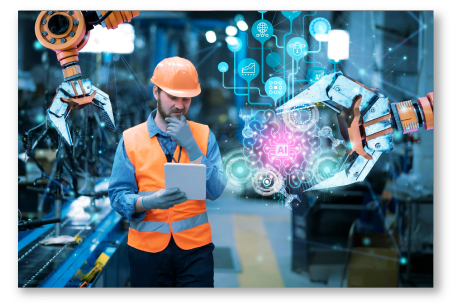Industries
Technology
Technology Industry
Information Technology is driving innovation, efficiency, and competitiveness in the technology sector. It empowers research and development, enabling engineers and scientists to create cutting-edge products and solutions.
IT infrastructure underpins manufacturing processes, ensuring precision and quality control. Moreover, it drives marketing and sales efforts, reaching global markets through e-commerce and digital advertising.

Cybersecurity, a critical component of IT, safeguards valuable intellectual property and customer data. In essence, IT is the cornerstone of the technology industry, propelling it forward, optimizing operations, and ensuring its continued evolution in the digital age.
Technology Industry IT Challenges

The technology industry faces several notable IT challenges. First and foremost is the constant battle against cyber threats, including data breaches and hacking attempts.
Maintaining robust cybersecurity measures to protect sensitive information is paramount. Secondly, as technology evolves rapidly, keeping pace with the latest advancements while ensuring compatibility with existing systems poses a persistent challenge. Integration of new technologies into existing infrastructure must be seamless
Third, managing big data is a formidable task. Extracting meaningful insights from vast datasets requires sophisticated IT solutions. Lastly, recruiting and retaining skilled IT professionals is an ongoing challenge, as demand for specialized talent continues to outstrip supply. Overcoming these hurdles is essential to sustaining innovation and competitiveness in the technology industry.
How Aerial Teknology is Helping the Technology Industry?
Digital technology is the driving force behind the transformation of the technology industry, reshaping the way businesses operate, innovate, and thrive. Here’s how Aerial Teknology supports digitalization in catalyzing changes across the technology sector:
Product Development and Innovation
Digital tools and technologies facilitate rapid prototyping, simulation, and testing. This accelerates the development of new products and services, enabling companies to stay ahead of competitors in a fast-paced market.


Customer Engagement and Marketing
Digital channels and social media platforms enable targeted marketing and real-time customer engagement. Data-driven insights help companies understand customer behavior, tailor products, and provide personalized experiences.
Data Analytics and AI
Big data analytics and Artificial Intelligence (AI) are transforming decision-making. Predictive analytics helps forecast market trends, while AI-driven algorithms optimize operations, from logistics to customer support.

Cybersecurity
The rise of digital operations has necessitated robust cybersecurity measures. Advanced cybersecurity technologies protect intellectual property, customer data, and critical infrastructure from cyber threats.
Remote Work and Collaboration
Digitalization supports remote work arrangements, enhancing productivity and workforce flexibility. Collaboration tools and cloud computing enable global teams to work seamlessly together.
Business Models and Revenue Streams
The digital shift has given rise to new business models, such as subscription services and software-as-a-service (SaaS), diversifying revenue streams for tech companies.
Global Reach
Digital platforms and e-commerce provide a global reach, allowing tech companies to tap into international markets with ease.
Cost Optimization
Cloud computing reduces the need for extensive IT infrastructure investments, offering scalable solutions and cost savings.
Environmental Sustainability
Digital technology contributes to sustainability efforts by optimizing energy use, enabling remote work, and promoting eco-friendly products and services.
Future of IT in the Education Industry
The future of IT in the education industry promises to be both exciting and transformative. Several key trends and developments are poised to shape this evolution:
- Edge computing will gain prominence as IoT devices proliferate. This technology allows data processing to occur closer to the data source, reducing latency and enabling real-time decision-making in various applications, from autonomous vehicles to smart cities.
- Quantum computing, still in its nascent stages, holds the potential to revolutionize computing power. It could solve complex problems that are currently computationally infeasible, advancing fields like cryptography and drug discovery.
- Widespread adoption of 5G networks will facilitate faster data transfer and low-latency communication, unlocking opportunities for IoT, augmented reality (AR), and virtual reality (VR) applications.
- AI and machine learning will continue to be integrated into technology products and services, enhancing automation, personalization, and predictive capabilities across industries.
- The technology industry will increasingly prioritize sustainability, with IT solutions aimed at reducing energy consumption, waste, and carbon footprint.
- As cyber threats evolve, IT will play a pivotal role in developing advanced cybersecurity measures, including AI-powered threat detection and zero-trust security models.
- The future will see a deeper collaboration between humans and machines. AI-driven tools and robotic automation will augment human capabilities in various sectors, from healthcare to manufacturing.
- The convergence of biotechnology and IT will lead to breakthroughs in healthcare, genomics, and personalized medicine, creating innovative solutions for disease prevention and treatment.
- The technology industry will foster greater international collaboration on digital standards, data governance, and ethical AI development to ensure responsible innovation.
While these advancements hold great promise, challenges such as equitable access, digital literacy, and maintaining the human element in education must be addressed. The future of IT in the education industry is undeniably dynamic and holds the potential to revolutionize how we learn, teach, and prepare for an increasingly digital and interconnected world.


